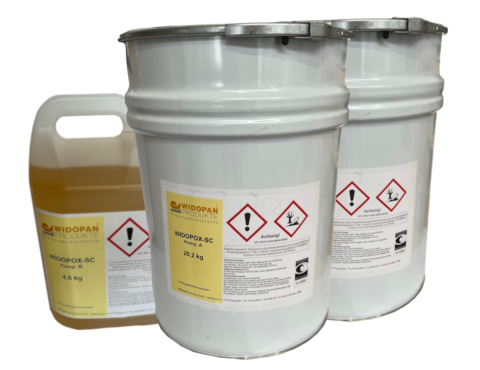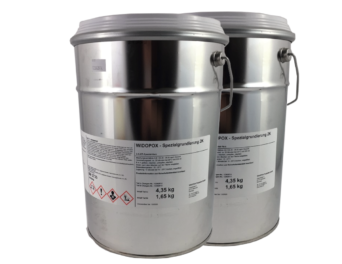WIDOPOX-SC
WIDOPOX-SC is a solvent free, coloured, 2-component coating made from Epoxy resin. It is used as a universal coating system. WIDOPOX-SC may be used as a primer, as a coating (with filling such as fire-dried quarz sand) and as a coloured sealing.
It’s range of application includes e.g. underground car parks, multy storey car parks (the material is certified as OS 8 system), storage areas, cellars or production halls and industrial buildings. It is highly wearable but has also a good chemical resistance.

Basis
2-K-Epoxy Resin
Consumption (within the OS 8 system)
As priming approx. 0,5 kg/m²,
As coating approx. 1,35 kg/m² filled with
approx. ca. 0,7 kg/m² Quarz sand (grain size 0,1-0,3 mm),
As coloured sealing approx. 0,65 – 0,8 kg/m²
Density
Finished mixture = approx. 1,4 kg/l
Working time / pot life (at +20 °C)
Approx. 30 min.
Curing time (at +20 °C)
Loadable after approx. 24 hours
Completely cured after approx. 5 – 7 days
Packaging sizes
20,2 kg (component A),
4,8 kg (component B)
Working temperature (of the surface)
+10 °C to +25 °C
Surrounding temperature and temperature of the material during processing
+15 °C to +25 °C
Relative humidity during processing
< 75%
Cleaning in fresh condition
WIDOPAN-Cleaner
Storage
If container is kept closed and storage temperature held constantly between +10 °C to +20 °C the product may be used for up to 12 months.
Available colours
Pebble grey – similar to RAL 7032,
Light grey – similar to RAL 7035,
Agate grey – similar to RAL 7038,
Concrete grey – similar to RAL 7023,
Traffic grey A – similar to RAL 7042,
Traffic grey B – similar to RAL 7043,
Traffic green - similar to RAL 6024,
Traffic red - similar to RAL 3020,
Traffic yellow - similar to RAL 1023,
Traffic blue - similar to RAL 5017,
Traffic black - similar to RAL 9017,
Traffic white - similar to 9016
Important note regarding the colour stability:
The colour might change over the years (yellowing effect). The change of colour depends e.g. on the UV-radiation and environmental conditions. However, it does not affect the physical and chemical resistances of the product. Products with intense colourings (e.g. hair dye or medical disinfection agents) as well as plasticiser may lead to discoloration of the surface.
Surface preparation
The surface to be primed must be dry, free from dust, grease and oil as well as adhesive and load-bearing. The surface needs to be prepared e.g. by sanding The substrate moisture of mineral substrates must not exceed 5% (otherweise a blocking of WIDOPOX Primer needs to be applied)
In general, curing and adhesion to the surface need to be tested.
Mixing
Component A needs to be stirred up homogeneously. Then, component B is added (mixing ratio: comp. A 4,2 kg : 1,0 kg comp. B) and both materials need to be mixed for approx. 2 minutes to get a homogeneous mixture. If filing material needs to be added, these need to be mixed with the resinf for at least another minute.
We recommend to use an agitator for mixing. The finished mixture needs to be decanted into another container and mixed again.
Application
– as priming
Pour stripes of the mixed material onto the surface.and spread it evenly with a rubber scraper. Afterwards, roll over it with a paint roller. WIDOPOX-SC should be applied as a sealed flm, pore, and capillary impermeable and then sprinkled with quartz sand (grain size 0,3 to 0,8 mm). If this cannot be achieved within one working process, a second priming layer has to be applied (within 12-24 hours after the first application)
– as a coating
The material mixture (including filler such as quartz sand) needs to be poured in stripes onto the surface and then spread with a suitable squeegee to achieve the requested layer thickness. Then, the material needs to be vented crosswise with a spiked roller.
– as a coloured sealing
Pour stripes of the mixed material onto the surface. At rough surfaces, spread the material evenly with a squeegee and then roll over it with a paint roller. At even surfaces the material is spreaded with a suitable paint roller.
Important note for application:
Within 24 hours during application and curing time the temperature needs to be at least 3°C above dew point. If the material gets in contact with dew or dampness during the curing time, the surface may be damaged. Further detail, especially regarding hazard statements, security advices and measures in the event of fire, can be found in the safety data sheet under sections 2, 4, 5, 6, 7 and 8.
Please also refer to our instructions on priming and our technical information sheets!
Download pdf
Additional products


 WIDOPOX-Special Primer 2K
WIDOPOX-Special Primer 2K